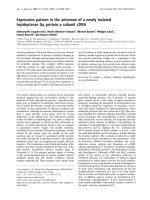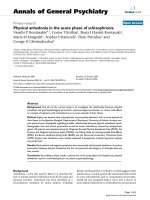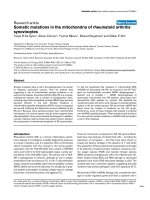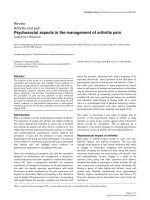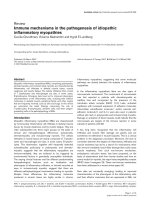Báo cáo y học: "Genetic polymorphisms in the nucleotide excision repair pathway and lung cancer risk: A meta-analysis"
Bạn đang xem bản rút gọn của tài liệu. Xem và tải ngay bản đầy đủ của tài liệu tại đây (206.24 KB, 13 trang )
Int. J. Med. Sci. 2007, 4
59
International Journal of Medical Sciences
ISSN 1449-1907 www.medsci.org 2007 4(2):59-71
© Ivyspring International Publisher. All rights reserved
Review
Genetic polymorphisms in the nucleotide excision repair pathway and lung
cancer risk: A meta-analysis
Chikako Kiyohara
1
and Kouichi Yoshimasu
2
1. Department of Preventive Medicine, Graduate School of Medical Sciences, Kyushu University, 3-1-1 Maidashi, Higashi-ku,
Fukuoka 812-8582, Japan.
2. Department of Hygiene, School of Medicine, Wakayama Medical University, 811-1 Kimiidera, Wakayama 641-8509, Japan
Correspondence to: Chikako Kiyohara, PhD, Department of Preventive Medicine, Graduate School of Medical Sciences, Kyushu Univer-
sity, 3-1-1 Maidashi, Higashi-ku, Fukuoka 812-8582, Japan. Tel: +81 92 642 6113; Fax: +81 92 642 6115; e-mail: chi-
Received: 2006.12.04; Accepted: 2007.01.30; Published: 2007.02.01
Various DNA alterations can be caused by exposure to environmental and endogenous carcinogens. Most of
these alterations, if not repaired, can result in genetic instability, mutagenesis and cell death. DNA repair
mechanisms are important for maintaining DNA integrity and preventing carcinogenesis. Recent lung cancer
studies have focused on identifying the effects of single nucleotide polymorphisms (SNPs) in candidate genes,
among which DNA repair genes are increasingly being studied. Genetic variations in DNA repair genes are
thought to modulate DNA repair capacity and are suggested to be related to lung cancer risk. We identified a
sufficient number of epidemiologic studies on lung cancer to conduct a meta-analysis for genetic polymor-
phisms in nucleotide excision repair pathway genes, focusing on xeroderma pigmentosum group A (XPA), exci-
sion repair cross complementing group 1 (ERCC1), ERCC2/XPD, ERCC4/XPF and ERCC5/XPG. We found an
increased risk of lung cancer among subjects carrying the ERCC2 751Gln/Gln genotype (odds ratio (OR) = 1.30,
95% confidence interval (CI) = 1.14 - 1.49). We found a protective effect of the XPA 23G/G genotype (OR = 0.75,
95% CI = 0.59 - 0.95). Considering the data available, it can be conjectured that if there is any risk association
between a single SNP and lung cancer, the risk fluctuation will probably be minimal. Advances in the identifica-
tion of new polymorphisms and in high-throughput genotyping techniques will facilitate the analysis of multi-
ple genes in multiple DNA repair pathways. Therefore, it is likely that the defining feature of future epidemi-
ologic studies will be the simultaneous analysis of large samples.
Key words: Lung cancer, nucleotide excision repair, meta-analysis, genetic polymorphism
1. Introduction
Sporadic cancer is a multifactorial disease that
results from complex interactions between many ge-
netic and environmental factors [1]. This means that
there will not be a single gene or single environmental
factor that has large effects on cancer susceptibility.
Environmental factors (e.g. tobacco smoke, dietary
factors, infectious agents and radiation) add to the
carcinogenic load to which humans are exposed, but
exact numbers for added risk are generally less well
established.
Cancer is the result of a series of DNA alterna-
tions in a single cell or clone of that cell, which leads
to a loss of normal function, aberrant or uncontrolled
cell growth and often metastasis. Several of the genes
that are frequently lost or mutated have been identi-
fied, including genes that function to induce cell pro-
liferation under specific circumstances (e.g. the ras
and myc proto-oncogenes) and those which are pro-
grammed to halt proliferation in damaged cells (e.g.
the TP53 and RB1 tumor suppressor genes). Other
mutations in genes involved in DNA repair are also
necessary. About 150 human DNA repair genes have
been identified to date [2], but the real number is
probably higher, since less than 50% of known and
putative genes have an identified function. The asso-
ciation between defects in DNA repair and cancer was
established by Cleaver in 1968 [3], who showed that
xeroderma pigmentosum (XP) is caused by deficient
nucleotide excision repair (NER). For more than a
quarter of a century after that it was thought that only
rare syndromes, such as XP, Cockayne syndrome (CS)
and ataxia telangiectasia, were associated with DNA
repair defects [4]. Novel, common polymorphisms in
DNA repair genes are continuously being identified,
and these polymorphisms may play a pivotal role in
sporadic carcinogenesis. A growing body of literature,
including observations of inter-individual differences
in measures of DNA damage, suggests that these
polymorphisms may alter the functional properties of
DNA repair enzymes.
At least four pathways of DNA repair operate on
specific types of damaged DNA. Base excision repair
(BER) operates on small lesions, while the NER path-
way repairs bulk lesions. Mismatch repair corrects
replication errors. Double-strand DNA break repair
(DSBR) actually consists of two pathways, homolo-
Int. J. Med. Sci. 2007, 4
60
gous recombination (HR) and non-homologous
end-joining (NHEJ). The NHEJ repair pathway in-
volves direct ligation of the two double strand break
ends, while HR is a process by which double-strand
DNA breaks are repaired through the alignment of
homologous sequences of DNA. The following sec-
tions review the literature on DNA repair genes in
more detail, specifically those involved in the NER
pathway.
NER is a versatile DNA repair system that re-
moves a wide range of DNA lesions including
UV-induced lesions. There are two subpathways in
NER. One is transcription-coupled DNA repair (TCR),
which preferentially removes DNA damage that
blocks ongoing transcription in the transcribed DNA
strand of active genes. The other is global genome re-
pair (GGR), which removes lesions throughout the
genome, including those from the nontranscribed
strand in the active gene [5]. Three rare, autosomal
recessive inherited human disorders are associated
with impaired NER activity: XP, CS and trichothio-
dystrophy (TTD) [6]. XP has been studied most exten-
sively. XP patients develop skin tumors at an ex-
tremely high frequency (1000 fold increased incidence
as compared to normal individuals) because of their
inability to repair UV-induced DNA lesions. These
clinical findings are associated with cellular defects,
including hypersensitivity to killing and the
mutagenic effects of UV and the inability of XP cells to
repair UV-induced DNA damage [7]. Approximately
80% of XP patients who have been classified have a
defect in the NER pathway. These patients are said to
have "classical" XP, in contrast to the remaining 20% of
patients who are designated as XP variants (XPV) and
most likely have a defect in post-replication repair. In
XPV patients, DNA replication stops or is interrupted
at sites of UV-damage. Furthermore, de novo DNA
synthesis opposite cyclobutane pyrimidine dimer le-
sions is prone to errors, leading to the fixation of mul-
tiple DNA mutations and ultimately to cancer. Seven
different DNA NER genes, which correct seven dis-
tinct genetic XP complementation groups (XPA, XPB
(ERCC3), XPC, XPD (ERCC2), XPE, XPF (ERCC4) and
XPG (ERCC5, this gene causes CS)) and XPV have
been identified [6]. XPA, ERCC3/XPB, ERCC2/XPD,
ERCC4/XPF and ERCC5/XPG have a defect in TCR
and GGR, while XPC and XPE have a defect in GGR
only. ERCC6 and ERCC8 are also known as CS type B
(CSB) and CSA, respectively. Approximately 20% of
patients have been assigned to the CSA complementa-
tion group Essentially CS shows some overlap with
certain forms of XP.
In contrast to XP and TTD,
however, the NER defect in CS is limited to the
TCR pathway.
As with XP, TTD involves mutations
in XP genes, usually XPD, which encodes a compo-
nent of the transcription factor TFIIH [8]. However, it
has been suggested that the functions of XPD associ-
ated with TTD are distinct from those of XPD associ-
ated with XP. Approximately half of the patients with
TTD display photosensitivity, correlated with the NER
defect.
The aim of this article is to review and evaluate
associations between genes in the NER pathway and
lung cancer risk, focusing on genes encoding five key
enzymes in this pathway: XPA, ERCC1, ERCC2/XPD,
ERCC4/XPF and ERCC5/XPG.
2. Materials and methods
2-1. Identification and eligibility of relevant studies
We conducted MEDLINE, Current Contents and
Web of Science searches using "XPA", "ERCC1",
"ERCC2/XPD", "ERCC4/XPF", "ERCC5/XPG", "lung
cancer" and "polymorphism" as keywords to search
for papers published (from January 1, 1966 through
May 31, 2006). Additional articles were identified
through the references cited in the first series of arti-
cles selected. Articles included in the meta-analysis
were in any language, with human subjects, published
in the primary literature and had no obvious overlap
of subjects with other studies. We excluded studies
with the same data or overlapping data by the same
authors. Case-control studies were eligible if they had
determined the distribution of the relevant genotypes
in lung cancer cases and in concurrent controls using a
molecular method for genotyping. Using the
MEDLINE database, we identified 5 genetic epidemi-
ological studies [9-13] that provided information on
lung cancer occurrence associated with the XPA G23A
polymorphism (one of the identified 6 candidate stud-
ies was excluded due to overlapping data [11]). We
identified 5 studies of the ERCC1 T19007C polymor-
phism (all of 5 candidate studies were independent
[13-17]). We gathered 18 articles on the ERCC2
312/751 polymorphisms found through literature
searches and checked their references for additional
relevant studies. Of the relevant 18 studies, 2 studies
appeared to be on populations already reported [14,
18, 19], leaving 15 independent studies (11 studies for
the Asp312Asn polymorphism [11, 13, 14, 17-24] and
14 studies for the Lys751Gln polymorphism [11, 13, 14,
17-19, 21-28]. Less than 5 studies each have been re-
ported on the ERCC1 C8092A, ERCC4/XPF Arg415Gln,
ERCC4/XPF Ser835Ser, ERCC5/XPG His46His,
ERCC5/XPG Asp1104His SNPs.
2-2. Data extraction and assessment of study quality
For each study, characteristics such as authors,
year of publication, ethnic group of the study popula-
tion, source of control population, number of geno-
typed cases and controls, crude odds ratio (OR) and
the method for quality control of genotyping were
noted. For studies including subjects of different eth-
nic groups, data were extracted separately for each
ethnic group whenever possible.
Methods for defining study quality in genetic
studies are more clearly delineated than those for ob-
servational studies. We assessed the homogeneity of
the study population (Caucasian or Asian).
2-3. Meta-analysis
Data were combined using both a fixed effects
(the inverse variance-weighted method) and a random
effects (DerSimonian and Laird method) models [29].
Int. J. Med. Sci. 2007, 4
61
The Cochrane Q statistics test is used for the assess-
ment of heterogeneity. The fixed effects model is used
when the effects are assumed to be homogenous,
while the random effects model is used when they are
heterogenous. In the absence of between-study het-
erogeneity, the two methods provide identical results.
The presence of heterogeneity can result from differ-
ences in the selection of controls, age distribution,
prevalence of lifestyle factors, histologic type of lung
cancer, stage of lung cancer and so on. The random
effects model incorporates an estimate of the be-
tween-study variance and tends to provide wider CIs
when the results of the constituent studies differ
among themselves. As the random effects model is
more appropriate when heterogeneity is present [29],
the summary OR and prevalence were essentially
based on the random effects model. The meta-analyses
were performed on crude ORs, since the adjusted ORs
were not comparable because of the inclusion of dif-
ferent covariates in the multivariate regression models.
Using individuals with the homozygous common
genotype as the reference group, we calculated ORs
for individuals with the heterozygous genotype and
homozygous rare genotype separately whenever pos-
sible (information available in at least two studies). In
some cases, we combined the heterozygous genotype
with the homozygous rare genotype due to a low
prevalence of the rare allele in several polymorphisms.
The Q statistic was considered significant for P<0.10
[30, 31]. Publication bias is always a concern in
meta-analysis. The presence of publication bias indi-
cates that nonsignificant or negative findings remain
unpublished. To test for publication bias, both Begg's
[32] and Egger's [33] tests are commonly used to as-
sess whether smaller studies reported greater associa-
tions than larger studies. Publication bias is consid-
ered significant for P<0.10. Publication bias may be
always a possible limitation of combining data from
various sources as in a meta-analysis. The idea of ad-
justing the results of meta-analyses for publication
bias and imputing "fictional" studies into a
meta-analysis is controversial at the moment [34].
Sutton et al. concluded that publication or related bi-
ases did not affect the conclusions in most
meta-analyses because missing studies changed the
conclusions in less than 10% of meta-analyses [34]. All
of the calculations were performed using STATA Ver-
sion 8.2 (Stata Corporation, College Station, TX) soft-
ware.
3. Results
3-1. DNA repair capacity and lung cancer risk
Cigarette smoke contains several thousand
chemicals that are known to chemically modify DNA
[35] and lead to the formation of mutations [36]. Most
of these compounds are procarcinogens that must be
activated by Phase I enzymes, such as cytochrome
P450s. All activated carcinogens can bind to DNA and
form DNA adducts that are capable of inducing muta-
tions and initiating carcinogenesis. The capacity to
repair DNA damage induced by activated carcinogens
appears to be one of the host factors that may influ-
ence lung cancer risk. A critical cellular response that
counteracts the carcinogenic effects of DNA damage is
DNA repair. As stated earlier, there are several known
pathways of DNA repair, all of which act to remove
DNA lesions and prevent mutations, thereby restoring
genetic integrity.
Several studies have investigated whether re-
duced DNA repair capacity (DRC) is associated with
an increased risk of cancer [37]. The reduced DRC of
benzo(a)pyrene-7,8-diol-9,10-epoxide (an active form
of benzo(a)pyrene)-DNA adducts is associated with
an increased risk of lung cancer (2.1-fold, 95% confi-
dence interval (CI) = 1.5 - 3.0) [38]. The reduced DRC
has been shown to be associated with a 5.7-fold (95%
CI = 2.1 - 15.7) increased risk of developing lung can-
cer [39]. Likewise, the reduced DRC of bleomy-
cin-induced damage was found to be associated with
an increased risk of lung cancer [40]. These studies
suggested that a low DRC of various DNA repair
mechanisms predisposes individuals to lung cancer,
and this realization prompted us to search for defined
DNA repair activities that may be risk factors for lung
cancer. Polymorphisms in DNA repair genes may be
associated with differences in the DRC of DNA dam-
age and may influence an individual's risk of lung
cancer, because the variant genotype in those poly-
morphisms might destroy or alter repair function.
3-2. XPA G23A polymorphism and lung cancer risk
The heterotrimeric replication protein A (RPA) is
required for NER and may play an important role in
the damage recognition process. The XPA protein is
required for NER and is involved in the DNA damage
recognition process. Both RPA and XPA preferentially
bind damaged DNA, and because RPA and XPA di-
rectly interact in the absence of DNA, the RPA-XPA
complex has been implicated as a key component in
the earliest stage of damage recognition [41]. There is
also evidence that the XPC-hHR23B protein complex
may initiate recognition of DNA damage for the
global genomic repair pathway of NER [42]. Recent
evidence also implicates the damaged DNA binding
protein heterodimer in damage recognition, because
the complex binds damaged DNA with high affinity
[43] and can dramatically increase the repair rate of
certain DNA adducts, including cyclobutane
pyrimidine dimers, in conjunction with XPA and RPA
[44].
The XPA maps on chromosome 9, at 9q22.3. In
the XPA gene, a polymorphic site was identified that
was in the 5' untranslated region (UTR) of the gene
and which consisted of a G-to-A (or A-to G) substitu-
tion in the fourth nucleotide before the ATG start
codon (dbSNP rs 1800975) [45]. SNP alleles with
higher frequencies are more likely to be ancestral than
less frequently occurring alleles although there may be
some exceptions. As the 23G allele was more preva-
lent than the 23A allele (Table 1), we regarded the 23G
allele as ancestral (wild-type or major) allele for de-
scriptive purposes (the XPA 23 polymorphism caused
by the G-to-A substitution is the XPA G23A poly-
Int. J. Med. Sci. 2007, 4
62
morphism). The polymorphism, termed the XPA
G23A polymorphism (at position 23 in the transcript,
four nucleotides upstream of the start codon), is in the
Kozak sequence near the start codon and thus may
affect the XPA protein levels in cells [46]. A functional
association between the XPA G23A polymorphism
and DRC has been reported [10]. It has been shown
that healthy subjects with at least one 23G allele have
significantly higher DRC. When the combined A/A
and A/G genotype was used as the reference, the
G/G genotype was associated with a significantly de-
creased risk of lung cancer (adjusted OR = 0.56, 95%
CI = 0.35 - 0.90) in Koreans [9]. A significant protective
effect of the combined G/A and G/G genotypes on
lung cancer risk was reported in Americans (adjusted
OR = 0.69, 95% CI = 0.53 - 0.90) and Mexi-
can-Americans (adjusted OR = 0.32, 95% CI = 0.12 -
0.83) [10]. Likewise, a protective and nonsignificant
effect was seen among Germans [11] and Danes [12].
As compared with the combined G/A and A/A
genotypes, the G/G genotype was, however, associ-
ated with a significantly increased risk of lung cancer
(adjusted OR = 1.59, 95% CI =1.12 - 2.27) in a Norwe-
gian population [13]. Summary frequencies of the 23A
allele among all and Caucasian populations, based on
the random effects model, were 0.368 (95% CI = 0.308 -
0.429) and 0.352 (95% CI = 0.277 - 0.428), respectively
(Table 1). Summary ORs for the G/A genotype and
G/G genotype among 5 studies in 7 populations were
0.73 (95% CI = 0.61 - 0.89) and 0.75 (95% CI = 0.59 -
0.95), respectively (Table 1). Evidence for heterogene-
ity was absent in both analyses. Among Caucasian
studies, the summary ORs for the G/A genotype and
the A/A genotype were 0.72 (95% CI = 0.58 - 0.89) and
0.82 (95% CI = 0.61 - 1.11), respectively. The Cochrane
Q test for heterogeneity did not show a statistical sig-
nificance. The Egger's test was statistically significant
for publication bias in a subgroup analysis of Cauca-
sians (P = 0.073, G/A genotype vs. G/G genotype).
Two studies investigated associations between
cigarette smoking and the G23A polymorphism in
relation to lung cancer. When stratifying by smoking
status, there was a significant protective effect for
current smokers who possessed the G/G genotype
(adjusted OR = 0.23, 95% CI = 0.07- 0.71) but not for
former or never smokers [9]. Ever smokers (current
and former) with at least one copy of the 23G allele
showed a significantly reduced risk of lung cancer
(adjusted OR = 0.68, 95% CI = 0.51 - 0.91) among Cau-
casians [10]. The presence of the 23A polymorphism,
however, was associated with a statistically significant
reduced risk in subjects who smoked >29 pack-years
(OR = 0.53, 95% CI = 0.17 - 0.97) [13]. Interactions be-
tween cigarette smoking and the polymorphism were
not determined in the studies [9, 10, 13]. No associa-
tions were seen between the G23A polymorphism and
any histologic types of lung cancer [11], while the
G/G genotype was associated with a significantly de-
creased risk for small cell lung cancer (OR = 0.23, 95%
CI = 0.07 - 0.71) [9].
The XPA G23A polymorphism may, thus, be a
promising SNP for lung cancer. It is thought that
cigarette smoking modifies the association between
DNA repair polymorphisms, as well as metabolic
polymorphisms, and lung cancer risk. Since interac-
tions between the G23A polymorphism and smoking
have not been fully elucidated, further studies are
needed to better understand the associations between
the XPA G23A polymorphism and lung cancer risk.
3-3. ERCC1 polymorphisms and lung cancer risk
The ERCC1 coding region is 1.1 kb long and
comprises 10 exons. This gene is located on 19q13.2 -
q13.3. Shen et al. [47] have identified polymorphisms
of three of the exons of the ERCC1 gene, all of which
resulted in silent mutations. No amino acid substitu-
tions were observed among the ERCC1 polymor-
phisms [48]. The functional effects of the silent poly-
morphisms in ERCC1 have not been fully elucidated;
however, some of the variant alleles of the polymor-
phisms in DNA repair genes may be associated with
the reduced DRC. The studies have focused on poly-
morphisms of the 3′ UTR (C8092A, dbSNP no.
rs3212986) and codon 118 (Asn118Asn, T19007C,
dbSNP no. rs11615) in ERCC1.
For the T19007 C (Asn118Asn) polymorphism,
although the T/T genotype generates the less com-
monly associated triplet codon sequence encoding the
amino acid and has been termed the "variant" by con-
vention, the T/T genotype indeed has been reported
to occur at higher frequencies. Hence, the T/T geno-
type is used as reference in this paper. The C/C geno-
type of the C8092A polymorphism is used as reference
on the same score.
The C/C genotype of the T19007C polymor-
phism was associated with a significantly decreased
risk of lung cancer (adjusted OR = 0.32, 95% CI = 0.19 -
0.55) in a Norwegian population [13]. A lack of asso-
ciation between the T19007C polymorphism and lung
cancer risk was observed in a Danish population [14],
a large American population [15], a Chinese popula-
tion [16] and a nonsmoking European population [17].
As shown in Table 2, summary frequencies of the
19007T allele among all and Caucasian populations,
based on the random effects model, were 0.499 (95%
CI = 0.387 - 0.611) and 0.575 (95% CI = 0.529 - 0.622),
respectively. The summary ORs for the T/C genotype
and the C/C genotype were 0.82 (95% CI = 0.62 - 1.08)
and 0.72 (95% CI = 0.46 - 1.11), respectively. Even if
the analysis was restricted to Caucasian studies, the
ORs did not materially change. The Cochrane Q test
for heterogeneity showed a statistical significance in
any analysis. In comparison of the T/C genotype with
the T/T genotype, the Begg's test was statistically sig-
nificant in an overall analysis (P = 0.086) and a sub-
group analysis of Caucasians (P = 0.089).
Two studies examined an interaction between
the T19007C polymorphism and cigarette smoking.
When stratified by smoking status, the interaction
between smoking and the polymorphism was not sta-
tistically significant [15, 16]. Only one study provides
information on the T19007C polymorphism and lung
cancer risk in histologic types. There was no difference
Int. J. Med. Sci. 2007, 4
63
in risk estimates according to the histological type of
lung cancer [16].
As for the C8092A polymorphism, no association
was found between the polymorphism and lung can-
cer risk in Norwegians [13] and Americans [15]. The
C8092A and T19007C polymorphisms have been re-
ported to be in linkage disequilibrium [15].
Although harboring at least one 19007C allele
may be associated with a deceased risk of lung cancer,
the protective effect of the 19007C allele needs to be
confirmed in other independent studies. Furthermore,
additional studies are needed to detect the function of
the ERCC1 polymorphisms.
3-4. ERCC2/XPD polymorphisms and lung cancer
risk
The ERCC2/XPD protein plays a role in the NER
pathway, which recognizes and repairs a wide range
of structurally unrelated lesions such as bulky adducts
and thymidine dimers. ERCC2/XPD works as an
ATP-dependent (5'→3') helicase joined to the basal
TFIIH complex used to separate the double helix. The
ERCC2/XPD protein is necessary for normal tran-
scription initiation and NER. ERCC2/XPD maps on
chromosome 19, at 19q13.3 and covers 21.14 kb. Muta-
tions in the ERCC2 gene can diminish the activity of
TFIIH complexes, giving rise to repair defects, tran-
scription defects and abnormal responses to apoptosis
[49].
A number of polymorphisms in the ERCC2/XPD
gene have been reported. Whereas polymorphisms in
the codons 199, 201 and 575 are rare, those in codons
156, 312, 711 and 751 are common. Two ERCC2/XPD
polymorphisms, Asp312Asn (db SNP no. rs1799793)
and Lys751Gln (db SNP no. rs13181), have mainly
been investigated in relation to phenotypic endpoints
relevant to lung carcinogenesis. With regard to the
Asp312Asn polymorphism, most of the reported data
indicate a higher level of DNA adducts in subjects
with the Asn allele. The interpretation of this finding
is a lower DRC for the Asn allele than the Asp allele.
This is also true for the ERCC2/XPD Lys751Gln poly-
morphism. The Gln allele is associated with a higher
DNA adduct level or lower DRC.
The Asp/Asp genotype of the ERCC2/XPD
Asp312Asn polymorphism was found to have an in-
creased risk of lung cancer when the combined
Asp/Asn and Asn/Asn genotypes served as reference
(OR = 1.86, 95% CI =1.02 - 3.40) in Polish men [20]. A
large American lung-cancer study also reported an
elevated risk (adjusted OR = 1.5, 95% CI = 1.1 - 2.0;
Asn/Asn genotype vs. Asp/Asp genotype) [18].
Likewise, Chinese subjects homozygous for the
Asn/Asn genotype had an increased risk of lung can-
cer (adjusted OR = 10.33, 95% CI = 1.29 - 82.50) com-
pared with subjects homozygous for the Asp/Asp
genotype [19]. No association with this polymorphism
was seen in an admixed population [21], a small
Swedish population [22] and among Finnish smoking
men [23]. Two meta-analyses have been published in
2004 [50] and 2005 [51], respectively. Both of them are
based on the same published data from 6 individual
case-control studies [18-23]. The first meta-analysis
showed that individuals with the Asn/Asn genotype
had a 27% (95% CI = 1.04 - 1.56) increased risk of lung
cancer compared with individuals with the Asp/Asp
genotype. The results supported the hypothesis that
individuals with the Asn/Asn genotype are at higher
risk of developing lung cancer [50]. The second
meta-analysis was somewhat different from the first
one, because unadjusted ORs were summarized in the
first one. The summary OR associated with the
Asn/Asn genotype was 1.18 (95% CI = 0.84 - 1.67). No
significant association between the ERCC2/XPD
Asp312Asn polymorphism and lung cancer was found
in the second meta-analysis [51]. Regardless, these
meta-analyses indicate that the excess lung cancer risk
from the Asn/Asn genotype may be less than 30%.
Five studies have been reported since the publi-
cation of these two meta-analyses. They revealed that
the Asp312Asn polymorphism was not associated
with lung cancer risk in Germans [11], Norwegians
[13], Danes [14], Europeans [17] and Chinese [24].
As shown in Table 3, the summary frequency of
the 312Asp allele among Caucasians (0.645, 95% CI =
0.572 - 0.719) was significantly lower than that among
Asians (0.936, 95% CI = 0.925 - 0.946). Summary ORs
associated with the ERCC2/XPD Asp312Asn poly-
morphism are also shown in Table 3. No significant
association between lung cancer and the heterozygous
Asp/Asn genotype was found for all of the studies
combined or by ethnicity. The Cochrane Q test for
heterogeneity did not show a statistical significance in
all analyses. Although no evidence of publication bias
was found in overall analyses, both Begg's (P= 0.035)
and Egger's (P = 0.003) tests showed a statistical sig-
nificance in a subgroup analysis of Caucasians
(Asn/Asn genotype vs. Asp/Asp genotype).
When stratifing by smoking dose, the risk of lung
cancer was significantly higher in light-smokers with
the Asp/Asp genotype than in those with the
Asn/Asn genotype [20]. Similar findings were not
seen for never-smoker or heavy-smokers [20]. A sig-
nificant interaction between smoking (smoking status,
pack-years and duration) and the polymorphism was
observed in one study [18] but not in two other studies
[16,19]. Stratification analysis revealed that the in-
creased risk was mainly confined to squamous cell
carcinoma of the lung, with the ORs being 20.50 (95%
CI = 2.25 - 179.05) for the 312Asn/Asn genotype [19].
Table 4 shows the association between the
ERCC2 Lys751Gln polymorphism and lung cancer risk.
The Gln/Gln genotype was associated with an in-
creased risk for lung cancer compared with the
751Lys/Lys genotype (adjusted OR = 2.71, 95% CI =
1.01 - 7.24) in Chinese [19]. Stratification analysis re-
vealed that the increased risk was mainly confined to
lung squamous cell carcinoma, with the OR being 4.24
(95% CI = 1.34 - 13.38) for the Gln/Gln genotype [19],
however. Although David-Beades et al. reported that
the Gln/Gln genotype was associated with a signifi-
cantly increased risk of lung cancer in Caucasians

